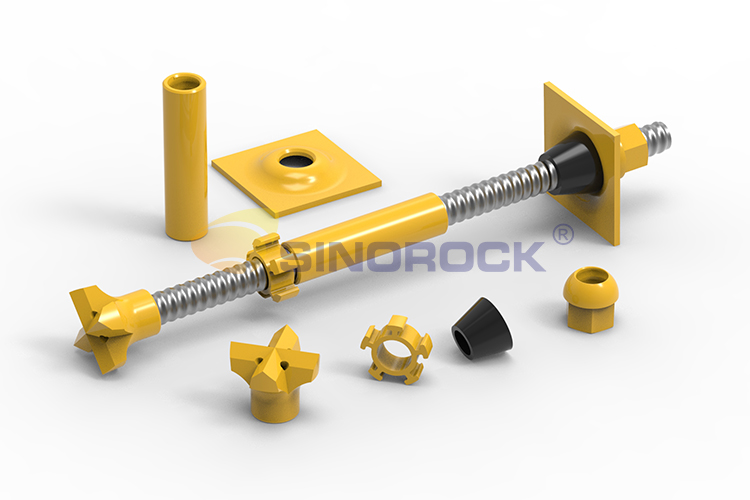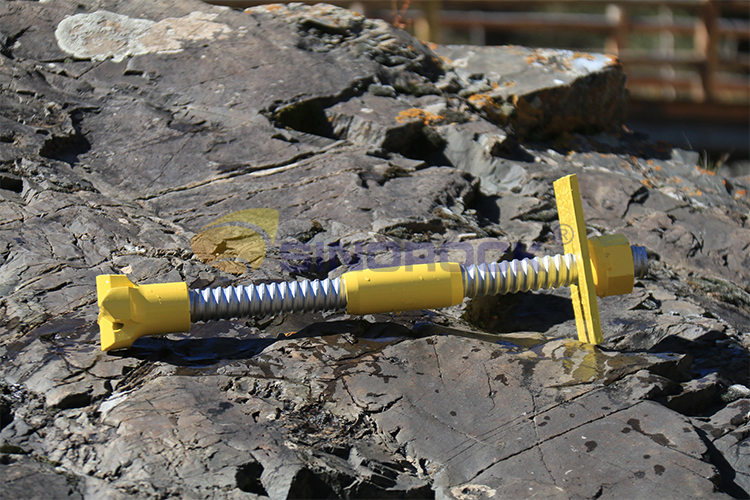3 Advantages of Self-drilling Pipe Roofing VS Traditional Pipe Roofing
Time:2024-01-26From:sinorock View:
Decoding Traditional Pipe Roofing
Definition and Components
Traditional pipe roofing stands as a time-honored methodology integral to tunnel construction. At its core, this approach relies on a systematic assembly of components, each playing a crucial role in fortifying the tunnel roof. The primary components include:
Steel Pipes
The backbone of traditional pipe roofing, steel pipes serve as load-bearing elements. These pipes are strategically arranged to distribute the weight of the tunnel roof and maintain structural stability. It primarily comprising seamless steel pipes of various specifications, such as Φ76×6, Φ89×5, Φ108×6, and Φ127×6.
Grout Material
Grout, a mixture of cement, water, and other additives, is utilized to fill the voids between the steel pipes. This process, known as grouting, enhances the cohesion of the structure and reinforces the load-bearing capacity of the entire roofing system.
Support Systems
To ensure the proper alignment and spacing of steel pipes during installation, support systems are employed. These systems play a critical role in maintaining the integrity of the tunnel roof by preventing misalignment or displacement of the components.
Construction Process
The construction process of traditional pipe roofing is a meticulous series of steps aimed at creating a robust foundation for tunnel roofs. The process can be broken down into the following key stages:
Site Preparation
Before the installation begins, thorough site preparation is essential. This involves clearing the tunnel area, assessing geological conditions, and establishing a foundation for the subsequent construction phases.
Steel Pipe Placement
Steel pipes are methodically placed in predetermined patterns to ensure optimal load distribution. The precise arrangement of these pipes is critical to achieving the desired structural integrity of the tunnel roof.
Grouting
The grouting process follows steel pipe placement, involving the injection of the grout material into the voids between the pipes. This step enhances the bonding between components, solidifying the structure and mitigating potential weaknesses.
Support System Installation
Support systems are integrated to maintain the alignment and spacing of steel pipes. This phase requires careful attention to detail, as any deviations may compromise the overall stability of the tunnel roof.
Applications
Traditional pipe roofing has established itself as a versatile solution across various tunnel projects. Its applications extend to:
Highway and Railway Tunnels
In transportation infrastructure, traditional pipe roofing provides a reliable method for ensuring the stability of tunnels beneath highways and railways. The load-bearing capacity of the structure is crucial in maintaining the safety and integrity of these critical passages.
Subways
The underground nature of subway tunnels often demands robust roofing solutions. Traditional pipe roofing proves effective in supporting the tunnel roof, offering a dependable solution for subway construction projects.
Hydropower Station Tunnels
In the context of hydropower projects, where tunnels are common for water conveyance, traditional pipe roofing serves as a resilient choice to withstand the dynamic conditions associated with such environments.
Advantages and Limitations
Advantages
- Proven Reliability: Traditional pipe roofing has a track record of success in providing stable and durable tunnel roofs.
- Cost-Effectiveness: The materials and techniques involved often contribute to a cost-effective solution for tunnel construction.
- Adaptability: Suitable for a range of tunneling projects, traditional pipe roofing adapts to different geological conditions.
Limitations
- Construction Time: The process of steel pipe placement and grouting can be time-consuming, impacting project timelines.
- Environmental Impact: Grouting materials may have environmental implications, necessitating proper disposal measures.
- Limited Adaptability to Weak Surrounding Rock: In projects with weak and broken rock conditions, traditional pipe roofing may face challenges in providing adequate support.
Pioneering the Future - Self-Drilling Pipe Roofing
Defining Self-Drilling Pipe Roofing
As tunnel construction technology advances, self-drilling pipe roofing emerges as a revolutionary and forward-looking alternative. Unlike its traditional counterpart, self-drilling pipe roofing integrates drilling and support installation into a seamless process.

Integration of Drilling and Support Installation
The hallmark of self-drilling pipe roofing lies in its ability to combine drilling and support installation in a single operation. This integration streamlines the construction process, reducing the need for sequential steps and enhancing overall efficiency.
Self-Drilling Mechanism
At the core of this innovation is the self-drilling mechanism. Self-drilling pipes are equipped with specialized drill bits, allowing for the simultaneous creation of boreholes and the installation of support elements. This eliminates the need for separate drilling equipment, resulting in a more compact and agile construction process.
The Self-Drilling Mechanism
Understanding the intricacies of the self-drilling mechanism is paramount to grasping how this innovation redefines tunnel construction. The process unfolds in the following stages:
Borehole Creation
Self-drilling pipes commence the construction process by autonomously creating boreholes as they are driven into the surrounding rock. The drill bits, tailored to project-specific requirements, effectively penetrate various geological conditions.
Simultaneous Support Installation
As the borehole is formed, the self-drilling pipes concurrently install support elements. These may include grout, steel reinforcements, or other specialized materials, depending on the project's demands. The simultaneous drilling and support installation expedite the construction timeline.
Tailored Applications
Self-drilling pipe roofing has carved a niche for itself in specific tunnel projects, particularly those grappling with weak and broken surrounding rock conditions.
Weak and Broken Surrounding Rock
In tunnel projects where traditional methods may face challenges due to weak and broken rock, self-drilling pipe roofing becomes a preferred choice. The ability to drill and provide support simultaneously enhances its effectiveness in navigating complex geological conditions.

Time-Critical Projects
Projects with stringent timelines benefit from the accelerated construction pace facilitated by self-drilling pipe roofing. The integration of drilling and support installation minimizes downtime, making it an ideal solution for time-sensitive endeavors.
Environmentally Sensitive Areas
In environmentally sensitive areas, where minimizing disturbance is paramount, the compact and efficient nature of self-drilling pipe roofing reduces the ecological footprint compared to traditional methods.
Advantages and Challenges
Advantages
- Rapid Construction: The integration of drilling and support installation accelerates the construction timeline.
- Adaptability to Weak Rock: Self-drilling pipe roofing excels in projects with weak and broken surrounding rock conditions.
- Reduced Environmental Impact: The streamlined process contributes to a reduced environmental footprint in sensitive areas.
Challenges
- Specialized Equipment: The adoption of self-drilling pipe roofing may require specialized equipment.
3 Advantages of Self-drilling Pipe Roofing VS Traditional Pipe Roofing
High Construction Efficiency
The self-drilling pipe roof system, featuring a hollow anchor bar, coupling sleeve, and drill bit, presents a transformative solution to the inefficiencies of traditional pipe roofs. In weak geological formations (grade IV and V), the traditional method often encounters problems like hole collapse and sticking, making it challenging to insert the pipe roof without additional casing. The self-drilling system, however, seamlessly addresses these issues by allowing drilling and grouting to occur simultaneously. This streamlined approach significantly enhances construction efficiency, making it a preferred choice in tunnel projects.
High Security in Support
One of the critical advantages of self-drilling pipe roofs lies in the high support rigidity they offer, coupled with minimal radial plastic deformation of the surrounding rock. This unique characteristic creates a robust bearing arch after support, ensuring enhanced safety during tunnel boring and initial support phases. The self-drilling system's ability to effectively handle the challenges posed by weak and broken rock formations adds an extra layer of security to tunnel construction projects.Advanced Support Functionality
Beyond traditional support roles, self-drilling pipe roofs play a pivotal role in advanced support. This functionality proves crucial in reducing surface settlement and preventing the collapse of surrounding rock. The advanced support aspect distinguishes self-drilling systems as proactive measures in maintaining the structural integrity of tunnels, especially in regions prone to geological challenges.
Sinorock's Self-drilling Roof Pipe Applacation Examples
The success stories of self-drilling pipe roofs are exemplified by their application in prominent projects like Zhengwan High-speed Railway, Zhangjihuai Railway, and Yumo Railway. Sinorock's R519.5, T7610.5, and T7612 self-drilling pipe roofs have replaced traditional specifications such as Φ766, Φ895, and Φ1086. This transition has not only met but exceeded project requirements, garnering praise from stakeholders and customers alike.
Conclusion
In the ever-evolving field of construction, the choice between self-drilling pipe roofing and traditional pipe roofing hinges on project requirements and priorities. Builders and contractors must weigh the advantages of each method against the specific needs of their projects. As technology continues to advance, the construction industry benefits from a diverse range of roofing options, each offering unique strengths to meet the demands of contemporary architecture.
latest news
-

- What Are the Applications of SDA Bolts in Hydropower Stations?
- Time:2025-08-21From:This Site
- Learn how self-drilling anchor bolts enhance slope stability, tunnel support, and dam reinforcement in complex geological conditions at hydropower stations. Optimize hydropower projects with efficient, cost-effective, and eco-friendly solutions.
- View details
-

- Slope Stabilization with SDA Bolts: Benefits & Applications
- Time:2025-08-19From:This Site
- Discover how self-drilling anchor bolts (SDA bolts) provide superior slope stabilization for highways, railways, and tunnels. Learn their key benefits, installation process, and real-world applications in loose or collapsible soils.
- View details
-

- How Self-Drilling Rock Bolts Enhance Tunnel Support in Fractured Rock?
- Time:2025-08-15From:This Site
- Discover how self-drilling rock bolts enhance tunnel support in fractured rock. Learn their benefits, installation steps, and real-world applications for safe, efficient tunneling.
- View details
-

- Sinorock 2025 Quality Month | Strengthening Quality Foundations, Empowering Product Excellence
- Time:2025-08-13From:This Site
- Sinorock’s 2025 Quality Month, themed “Strengthening Quality Foundations, Empowering Product Excellence,” successfully concluded, reinforcing our commitment to superior product quality.
- View details
-

- Sinorock Safety Month 2025 | Everyone Speaks Safety, Everyone Can Respond
- Time:2025-07-03From:This Site
- Sinorock Safety Month 2025, centered on the theme "Everyone Speaks Safety, Everyone Can Respond - Spot Workplace Hazards," has wrapped up successfully!
- View details
-

- Quality Control: the Vital Factor of A SDA Bolt Factory
- Time:2025-01-09From:This Site
- Sinorock’s comprehensive quality control system, from supplier management to outgoing inspections, ensuring the highest standards for self-drilling anchor bolts in construction.
- View details
-

- Sinorock Invites You to Explore Proven Self-Drilling Anchor Bolt Solutions at bauma 2025
- Time:2025-03-07From:This Site
- From April 7–13, 2025, explore Sinorock’s Self-drilling anchor bolt solution at Booth C2.513/4 in Hall C2 of the Messe München Exhibition Center (Munich, Germany).
- View details
-
.jpg)
- SINOROCK to Attend EXPOMINA PERÚ 2024 in Lima, Peru
- Time:2024-08-10From:This Site
- Sinorock to Attend EXPOMINA PERÚ 2024 in Lima, Peru
- View details
-
.jpg)
- SINOROCK to Participate in MINING AND METALS CENTRAL ASIA 2024
- Time:2024-08-08From:This Site
- SINOROCK to Participate in MINING AND METALS CENTRAL ASIA 2024
- View details
 Download
Download 


